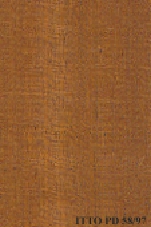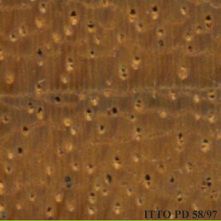
SIPO (Entandrophragma utile)
Trade Name
Sipo
Scientific Name
Entandrophragma utile Sprague
Family
MELIACEAE
Common Names
Sipo (Côte d`Ivoire); Sipo-Mahagony (Germany); Kalungi (Zaire); Undianuno; Tsimaie tshibu; Tshimaie n`shibu; Timbi; Sapele mahogany; Muyovu; Mufumbi mahogany; Mfumbi; Mebrou; M`vovo; Libuyu; Feather sapele; Efuobrodidwo; Efuo-konkonti; Efuchyewee; Budongo heavy mahogany; Bokoi; Akuk; Afrobrodiju; Kosi-kosi (Gabon); Assie (Cameroon); Okeong (Nigeria); Efuodwe (Ghana); Sipo-mahagoni (Germany); Utile (United Kingdom); Mufumbi (Uganda); Kalungi (Angola); Liboyo (Zaire); Assi (Gabon); Abebay (Equatorial Guinea); Asseng-assie (Cameroon); Utile (Nigeria); Utile (Ghana); Sipo
Scientific Name Synonyms
Pseudocedrella utilis Dawe & Sprague; Pseudocedrela utilis Dawe & Sprague; Entandrophragma roburoides Vermoes.; Entandrophragma macrocarpum A. Chev.
Description Of The Tree
Botanical Description
The tree grows to a height of more than 50 m, with trunk diameter above up to 200 cm. The bole is straight, cylindrical and clear to 32 m, occasionally fluted. Log is banned for international trading.(Cameroon)
Natural Habitat
Entandrophragma utile grows in moist deciduous primary forests, dry subtypes and transitional formations. There are protected populations and felling limits in various countries. National conservation status in Cote d`Ivoire V, Liberia E.
Natural Distribution
West and Central Africa.
Plantations Available?
It is a long rotation species for plantation. Best results are obtained in evergreen dense forests in comparison with plantations in semi-deciduous forest.
Wood Identification
Anatomic Description Of Wood
Wood diffuse porous. Occasionally vessels exclusively solitary (over 90%). Tangential diameter of vessel lumina 200 micras or more (large). Brown-colored deposits in heartwood vessels. Non-vestured pits. Vessels per mm2 less than 6 (rare). Simple perforation pl Axial parenchyma in marginal or in seemingly marginal bands. Paratracheal axial parenchyma scanty and/or vasicentric. Axial parenchyma in discontinuous tangential lines. Occasionally axial parenchyma storied. Prismatic crystals in non-chambered axial parenchy 4 to 10 rays per mm (medium). Occasionally rays storied. Rays 1 to 4 seriate. Body ray cells procumbent with one row of upright and/or square marginal cells (Kribs-III). Septate fibers present. Fibers with simple to minutely bordered pits.
-
 Wood Macro Photo Tangential Plane
Wood Macro Photo Tangential Plane
-
 Wood Micro Photo Of Transversal Section
Wood Micro Photo Of Transversal Section
Availability
Cites Status
Unrestricted
General Wood Description
Color
The sapwood is pinkish white, it has a thickness of 2 to 6 cm. The heartwood is red brown, slightly purplish, it is clearly demarcated. The silver figure is medium.
COLOR INDEX (1=Black, 7=Light yellow,white)
4
Grain
The grain is slightly but systematically interlocked; special care is needed when drying because of frequent risks of distortion.
Texture
Texture is reported to be fine to medium.
Luster
It is reported to be moderate in luster.
Natural Durability
Because of its variable resistance it is considered as moderately durable to decay. Without treatment, it can be used when risks of occasional re-humidification; it is not suited for uses with risks of permanent or long-lasting humidification. Moderately
Natural durability index (1= Very high durability, 7=Vey low durability)
4
Internal Growth Stresses
Residual growth stresses are absent.
Silica Content
Silica Content: Negligible contents of silica are found in timber of this species. Amounts over 0.05% may affect the wood processing. Silica Value: 0.02
Resistance To Impregnation
Nearly impossible to treat with a too much low penetration of the preservative substances.
Wood Physical Properties
Basic Density or Specific Gravity (O.D. weight/vol. green) (g/cm³)
0.56
Air-dry Density (Weight and volume at 12%MC) (g/cm³)
0.62
Total shrinkage Tangential (Saturated to 0%MC) (%)
6.4
Total shrinkage Radial (Saturated to 0%MC) (%)
4.6
Drying Defects
Ease of Drying: Drying is moderately easy; some particular care is needed. Drying Defects: No particular risks of drying defects, subject to normal drying conditions. Kiln Schedules: The kiln schedule has been tested.
Recommended Dry Kiln Schedule
FR-6
Dimensional stability ratio (Total Tangential Shrinkage %/Total Radial Shrinkage %)
1.4
Wood Chemical Properties
Wood Mechanical Properties
Bending Strength (MOR),12%MC (kgf/cm²)
930
Stiffness (MOE) 12%MC (kgf/cm²)
134984
Compression parallel to fiber 12%MC (kgf/cm²)
568
Compression perpendicular to fiber 12%MC (kgf/cm²)
74
Shear strength radial 12%MC (kgf/cm²)
74
Janka hardness (side) 12%MC (kgf)
469
Janka hardness (end grain) 12%MC (kgf)
573
Workability
Sawing
It is easy to saw.
Rotary Veneer Cutting
Suitable for slicing, also suitable for peeling if treated.
Sliced Veneer
Suitable for slicing, also suitable for peeling if treated.
Blunting Effect
Slight blunting effect; ordinary tools can be used for sawing and machining.
Machining
Machining of this species is reportedly easy.
Planing
Moderately easy; tools must be cautiously sharpened.
Moulding
Rather difficult; special tools are needed.
Turning
30
Boring
Rather difficult; special tools are needed.
Mortising
Rather difficult; special tools are needed.
Nailing
No particular problem.
Gluing
Difficult to glue because of the extracts content.
Sanding
Easy to perform; it gives good results.
Polishing
Can be polished without surface preparation.
Steam Bending
Steam bending is difficult.
Response To Hand Tools
No particular problems.
REFERENCED USES
End Uses Summary
HOUSING GENERAL, beams, joists, boards, flooring, parquet, frames, steps, panelling, fittings, FURNITURE AND CABINETS, luxury furniture, cabinets, PLYWOOD AND VENEER, faces, Decorative veneer, TURNING, ornaments, turned furniture, NAVAL CONSTRUCTION, boats, boat hulls, boat deck, port storage, OTHER AND MUSICAL INSTRUMENTS, moldings
General Housing
- 10 - Silica in Timbers
Beams
- 11 - Prospect: The wood database
Joists
- 12 - Tropical timbers of the world. Part I-Tropical American Species
Boards
- 13 - Dry kiln schedules for commercial woods. Temperate and tropical. Section III. Latin American (Mexico, Central, and South America) Woods–Conventional Temperatures
Flooring
- 14 - Handbook of Hardwoods
Parquet
- 15 - Empire Timbers
Frames
- 16 - Woods of the World
Steps
- 17 - Tree Conservation Database
Paneling
- 18 - W3TROPICOS Missouri Botanical Garden
Fittings
- 19 - Silica in Timbers
Furniture Cabinets
- 21 - Tropical timbers of the world. Part III-Southeast Asian and Oceanian Species.
Furniture, Luxury
- 22 - Dry kiln schedules for commercial woods. Temperate and tropical. Section IV-Asian and Oceanian Woods
Cabinet
- 24 - Empire Timbers
Panels, Veneers
- 25 - Directory of Timber Trade Malaysia
Faces
- 26 - Annual Review and Assessment of the World Timber Situation 1998-ITTO
Decorative veneer
- 28 - Ministry of Agriculture, Fisheries & Forest of Fiji
Turning
- 30 - Embassy of Honduras in Japan
Ornaments
- 31 - Embassy of Colombia in Japan
Turned Articles
- 32 - Embassy of Cote d`Ivoire in Japan
Shipbuilding
- 55 - Tropical Timber Atlas of Latin America
Boats
- 56 - Manual de Identificación de Especies Forestales de la Subregión Andina.
Boat Hulls
- 57 - Estadísticas de Aprovechamiento, Exportación y comercialización Nacional de Productos Forestales
Boat Decking
- 59 - Programa Nacional de uso Sostenible de los Bosques e Incremento a las Exportaciones.
Port Storage
- 62 - Estudio Tecnológico de Maderas del Perú (Zona Pucallpa) Vol I
Molding
- 79 - Padronização da Nomenclatura Comercial Brasileira das Madeiras Tropicais Amazônicas, Sugestão
Please Provide Information To View Producer Information